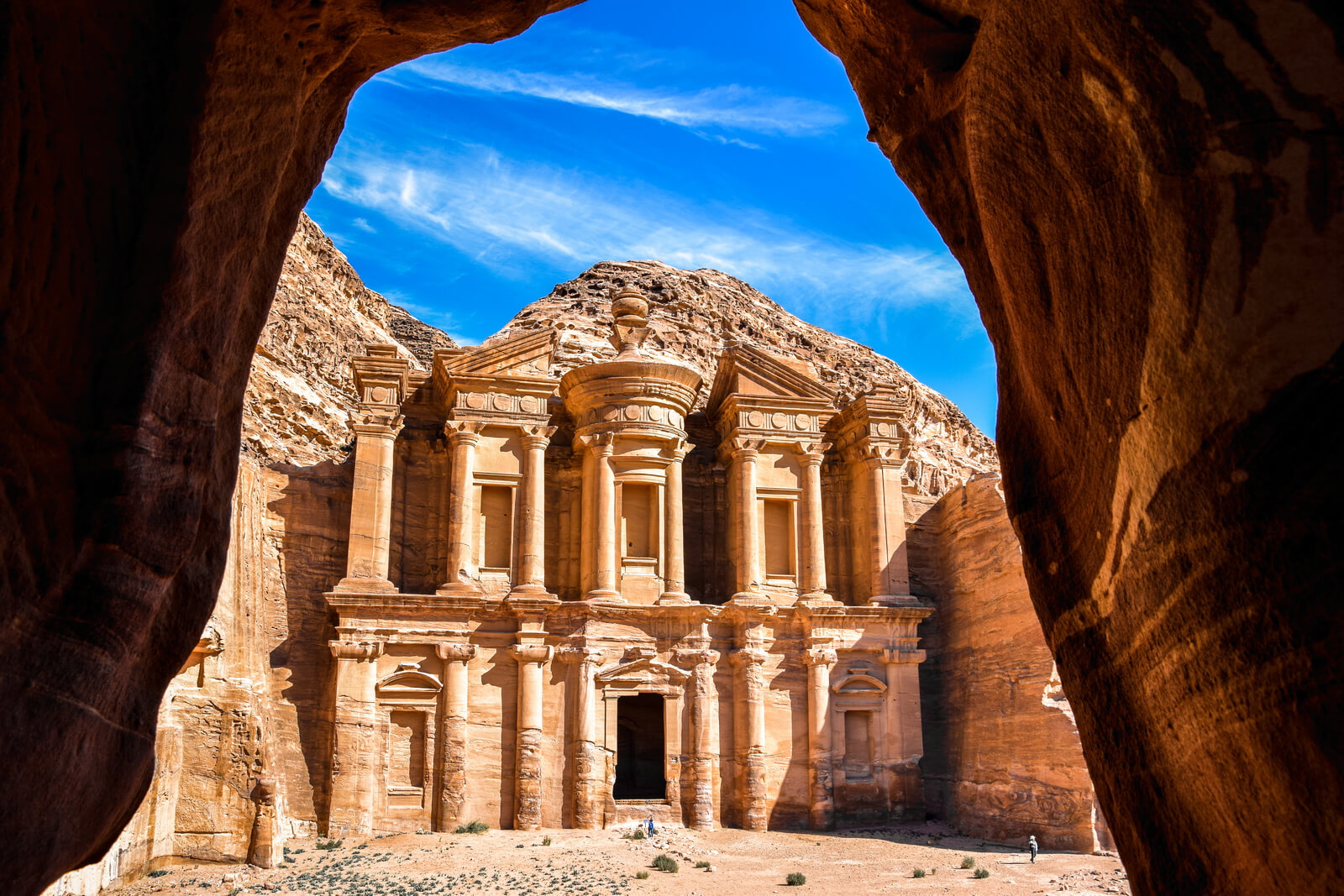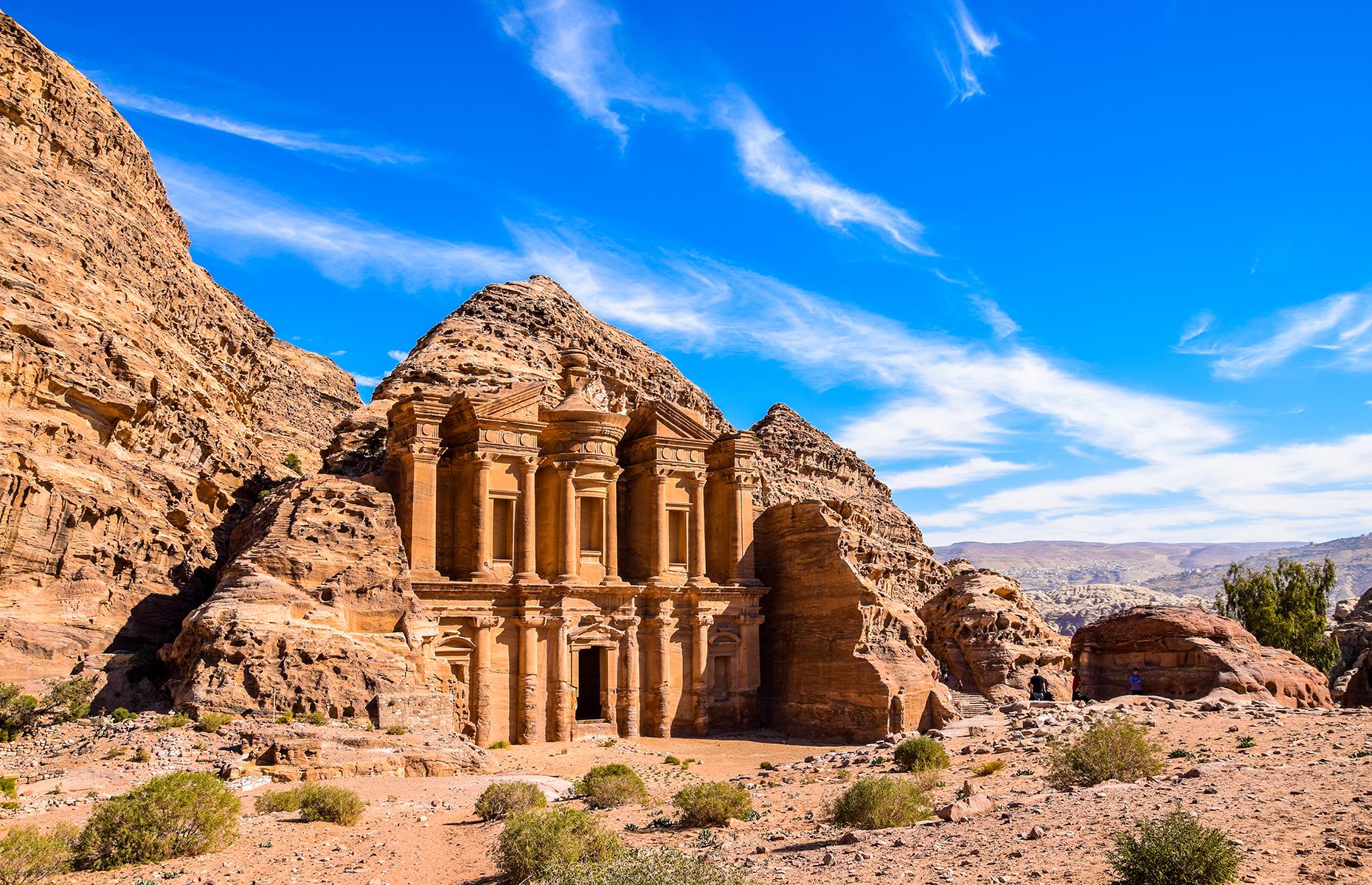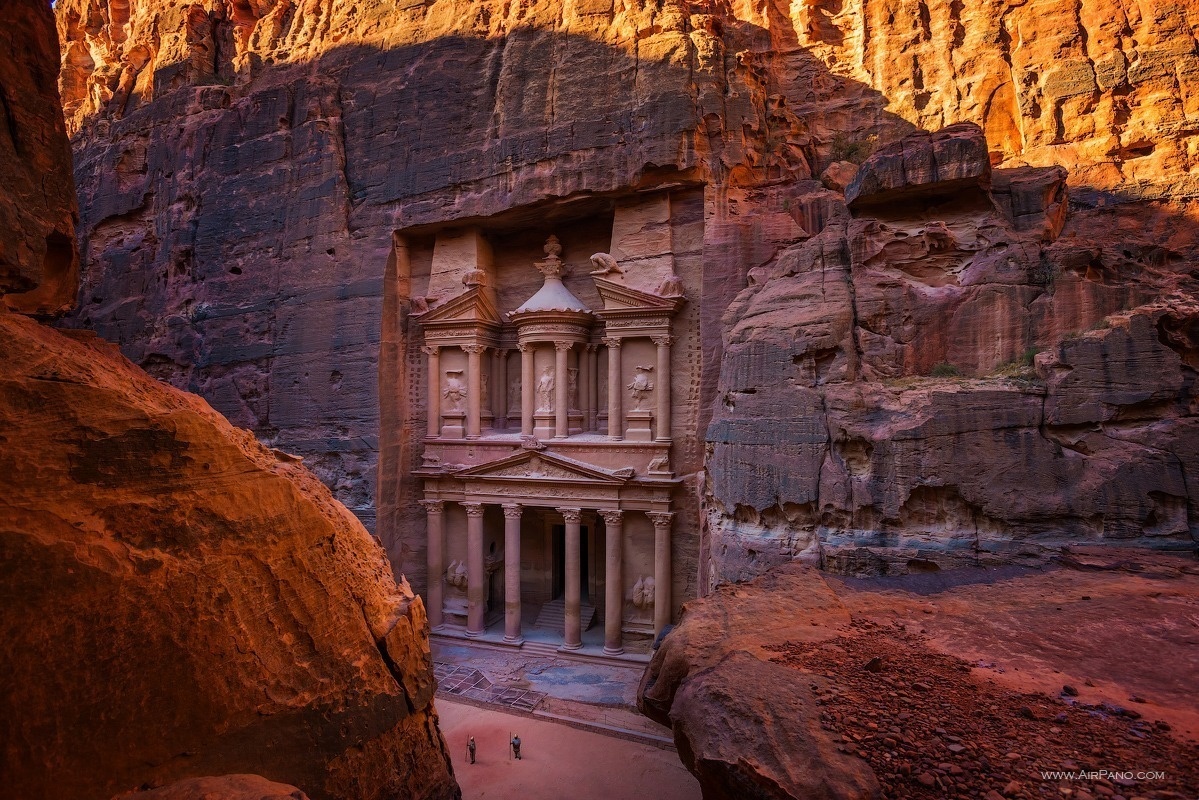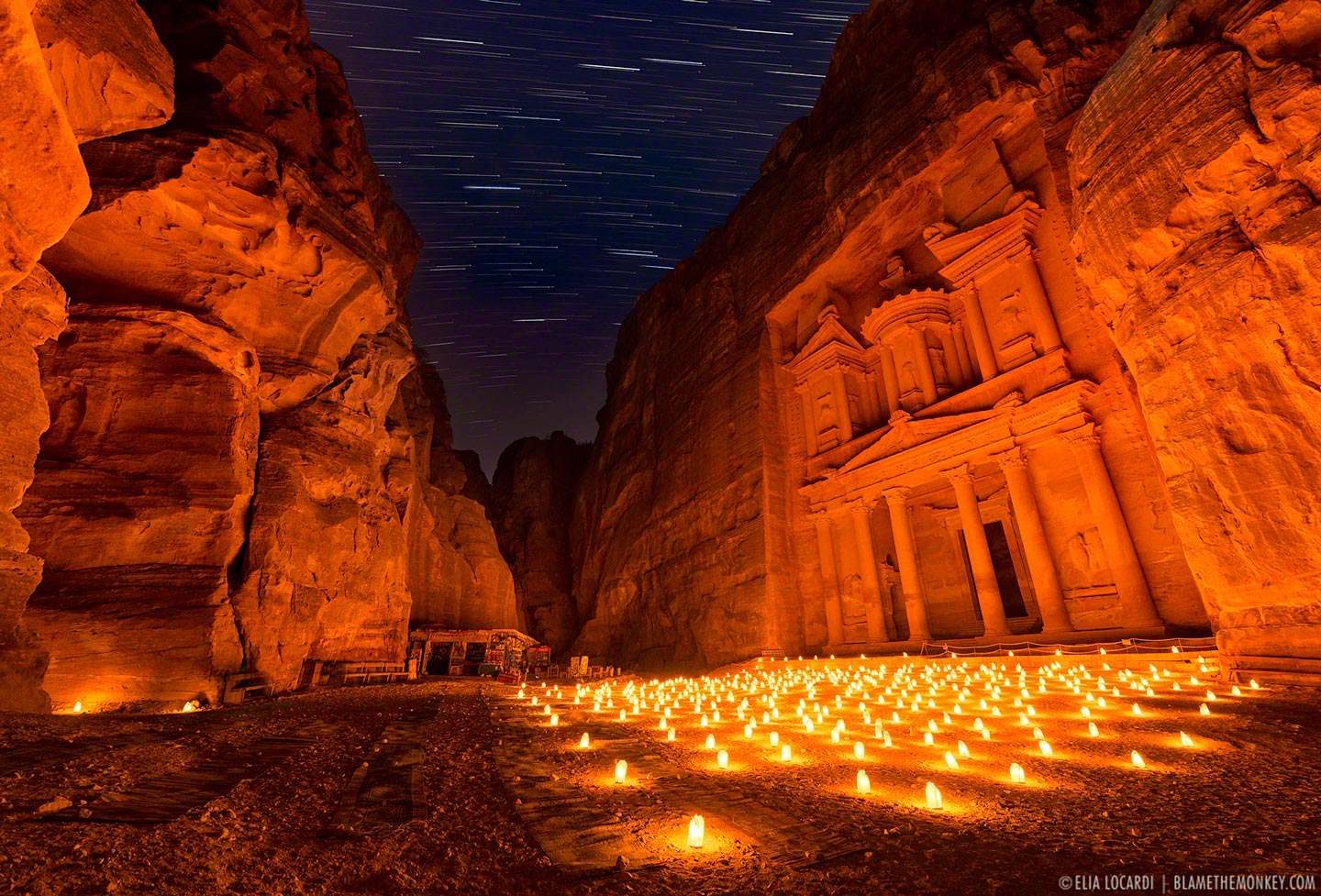Petra
Petra
Petra is an ancient city located in southern Jordan. Here is some full information about Petra:
- Historical Significance: Petra was the capital city of the Nabataean Kingdom, an ancient Arab civilization that flourished from the 4th century BC to the 1st century AD. It served as a major trading hub and played a significant role in the caravan trade routes that connected Arabia, Egypt, and Syria.
- Architecture and Monuments: Petra is renowned for its impressive rock-cut architecture. The city is famous for the Treasury (Al-Khazneh), a stunning mausoleum carved into the sandstone cliffs. Other notable structures include the Monastery (Ad Deir), the Royal Tombs, the Roman Theater, and the Temple of Qasr Al-Bint.
- The Siq: The main entrance to Petra is through a narrow and winding gorge called the Siq. This impressive pathway, flanked by towering cliffs, leads visitors to the Treasury. Walking through the Siq is an awe-inspiring experience.
- UNESCO World Heritage Site: Petra was designated as a UNESCO World Heritage Site in 1985 due to its outstanding archaeological and cultural value. It is considered one of the most important archaeological sites in the world.
- Petra by Night: A popular attraction is the "Petra by Night" experience, where the Treasury is illuminated by candlelight, creating a magical atmosphere. This event takes place a few times a week and involves a guided walk through the Siq.
- Tourism and Accessibility: Petra attracts tourists from around the world and is a major tourist destination in Jordan. The city is accessible by road from the nearby town of Wadi Musa and is about a three-hour drive from the capital city, Amman.
Visiting Petra provides an opportunity to explore the rich history and architectural marvels of this ancient city, immersing oneself in the unique beauty and cultural heritage of the Nabataean civilization.
- Location: Petra is situated in a narrow valley within the Shara Mountains of southern Jordan. It is approximately 235 kilometers (146 miles) southwest of the capital city, Amman.
- Nabataean Civilization: The Nabataeans, who built and inhabited Petra, were skilled traders and expert water engineers. They developed advanced techniques to channel and store water, allowing for the survival of a sizable population in the arid region.
- Treasury (Al-Khazneh): The Treasury is the most iconic and well-preserved structure in Petra. It is believed to have been constructed in the 1st century BC and gets its name from the legends that suggest it was once used to store hidden treasures. The Treasury's intricate façade is adorned with decorative elements and columns.
- Monastery (Ad Deir): The Monastery is another prominent monument in Petra. It is larger than the Treasury and is located high up on a hill, requiring a challenging uphill hike to reach it. The Monastery's impressive façade and the panoramic views from its location make it a must-visit site.
- High Place of Sacrifice: This elevated area in Petra offers panoramic views of the surrounding landscape. It was likely used for religious ceremonies and sacrifices by the Nabataeans.
- Petra Archaeological Museum: Situated near the entrance of Petra, the museum displays artifacts and exhibits that provide further insights into the history, culture, and architecture of Petra and the Nabataean civilization.
- Hiking Trails: Beyond the main sites, Petra offers various hiking trails that allow visitors to explore the surrounding mountains and valleys. These trails offer unique perspectives and less crowded areas to discover.
- Local Bedouin Culture: The Bedouin people, who have ancestral ties to the Nabataeans, reside in and around Petra. Interacting with the local Bedouin community can provide a deeper understanding of the area's heritage and traditions.
- Conservation Efforts: The preservation of Petra is a collaborative effort involving the Jordanian government, international organizations, and local communities. Conservation initiatives aim to protect the fragile structures and ensure the sustainable management of the site.
- Rock-cut Tombs: In addition to the Treasury and the Monastery, Petra is home to numerous rock-cut tombs. These elaborate burial chambers showcase the craftsmanship and architectural skills of the Nabataeans. Some notable tombs include the Tomb of the Roman Soldier, the Palace Tomb, and the Corinthian Tomb.
- Water Management System: One of the remarkable aspects of Petra is its sophisticated water management system. The Nabataeans ingeniously collected and channeled water through a network of dams, cisterns, and rock-cut channels. This system allowed them to control and distribute water to meet the needs of the city's inhabitants and sustain agriculture.
- Trade Routes and Cultural Exchange: Petra's strategic location made it a vital junction for various trade routes, facilitating the exchange of goods, ideas, and cultures between the Arabian Peninsula, Egypt, and the Mediterranean regions. This cultural exchange is reflected in the architectural styles and artistic influences found in Petra's structures.
- Influence of Nabataean Art: Nabataean art exhibits a blend of Hellenistic, Egyptian, Assyrian, and local Arabian influences. The intricate carvings, sculptures, and decorative motifs found in Petra showcase the unique artistic style and craftsmanship of the Nabataeans.
- Petra's Rediscovery: Petra remained unknown to the Western world for centuries until its rediscovery by the Swiss explorer Johann Ludwig Burckhardt in 1812. Burckhardt's accounts of the ancient city sparked international interest and led to further exploration and excavation efforts.
- Filming Location: Petra's dramatic and otherworldly landscape has attracted filmmakers over the years. The iconic Treasury was featured prominently in the movie "Indiana Jones and the Last Crusade," further popularizing Petra on the global stage.
- Tourism in Petra: Tourism plays a significant role in Petra's economy. The site welcomes a large number of visitors each year, and efforts are made to balance tourism with sustainable practices to ensure the long-term preservation of the site.
- Nearby Attractions: The region surrounding Petra offers additional attractions worth exploring. These include Wadi Rum, a desert valley known for its stunning landscapes and Bedouin culture, and the Dead Sea, a famous saltwater lake known for its therapeutic properties.
- Al-Deir (The Monastery): The Monastery, also known as Al-Deir, is one of the largest structures in Petra. It is located high up in the mountains and requires a challenging uphill hike to reach. The Monastery's facade is similar in style to the Treasury but on a grander scale. Inside, there is a large chamber that is believed to have been a Nabataean tomb or a place of worship.
- The Great Temple: The Great Temple of Petra was an important religious and ceremonial complex. Although much of it is now in ruins, you can still see the remains of the temple platform, colonnaded courtyard, and the grand staircase leading up to it. The temple was dedicated to the Nabataean gods and was an important center of religious activity.
- Street of Facades: The Street of Facades is a row of monumental tombs carved into the rock face. These tombs, with their intricately decorated facades, were the final resting places of wealthy Nabataeans. The street served as a grand entrance to the city and is an impressive sight to behold.
- Royal Tombs: The Royal Tombs are a collection of ornate tombs located on the eastern side of Petra. These tombs, including the Urn Tomb, the Silk Tomb, and the Corinthian Tomb, were built for the Nabataean kings and other members of the elite. The tombs are distinguished by their grandeur and detailed architectural features.
- High Place of Sacrifice: The High Place of Sacrifice is an elevated platform located on top of a mountain. It was used for religious ceremonies and offerings to the gods. From this vantage point, you can enjoy panoramic views of Petra and its surrounding landscapes.
- Petra Museum: The Petra Museum, located near the entrance of Petra, provides further insights into the history and culture of the Nabataeans. The museum showcases a collection of artifacts discovered in Petra, including pottery, jewelry, statues, and inscriptions, giving visitors a deeper understanding of the ancient city and its inhabitants.
- Petra at Sunrise and Sunset: Witnessing Petra at sunrise or sunset is a magical experience. The changing colors of the sandstone cliffs, combined with the soft light, create a breathtaking atmosphere. Many visitors choose to hike to the viewpoints early in the morning or late in the afternoon to capture the stunning beauty of Petra during these times.
Petra is a vast archaeological site with numerous hidden gems and fascinating details to explore. Its rich history, stunning architecture, and natural surroundings make it an exceptional destination that continues to captivate travelers from around the world.
पेट्रा दक्षिणी जॉर्डन में स्थित एक प्राचीन शहर है। पेश है पेट्रा के बारे में कुछ पूरी जानकारी:
- ऐतिहासिक महत्व: पेट्रा नबातियन साम्राज्य की राजधानी थी, जो एक प्राचीन अरब सभ्यता थी जो चौथी शताब्दी ईसा पूर्व से पहली शताब्दी ईस्वी तक फली-फूली। इसने एक प्रमुख व्यापारिक केंद्र के रूप में कार्य किया और अरब, मिस्र और सीरिया को जोड़ने वाले कारवां व्यापार मार्गों में महत्वपूर्ण भूमिका निभाई।
- वास्तुकला और स्मारक: पेट्रा अपनी प्रभावशाली रॉक-कट वास्तुकला के लिए प्रसिद्ध है। यह शहर राजकोष (अल-खज़नेह) के लिए प्रसिद्ध है, जो बलुआ पत्थर की चट्टानों में उकेरा गया एक आश्चर्यजनक मकबरा है। अन्य उल्लेखनीय संरचनाओं में मठ (अद देइर), शाही मकबरे, रोमन थियेटर और कसर अल-बिंट का मंदिर शामिल हैं।
- सीक: पेट्रा का मुख्य प्रवेश एक संकीर्ण और घुमावदार घाटी के माध्यम से होता है जिसे सीक कहा जाता है। यह प्रभावशाली मार्ग, विशाल चट्टानों से घिरा हुआ है, जो आगंतुकों को ट्रेजरी तक ले जाता है। सीक के माध्यम से चलना एक विस्मयकारी अनुभव है।
- यूनेस्को विश्व धरोहर स्थल: पेट्रा को इसके उत्कृष्ट पुरातात्विक और सांस्कृतिक मूल्य के कारण 1985 में यूनेस्को की विश्व धरोहर स्थल के रूप में नामित किया गया था। इसे दुनिया के सबसे महत्वपूर्ण पुरातात्विक स्थलों में से एक माना जाता है।
- पेट्रा बाय नाइट: एक लोकप्रिय आकर्षण "पेट्रा बाय नाइट" अनुभव है, जहां मोमबत्ती की रोशनी से ट्रेजरी को रोशन किया जाता है, जिससे एक जादुई वातावरण बनता है। यह घटना सप्ताह में कुछ बार होती है और इसमें सीक के माध्यम से निर्देशित चलना शामिल है।
- पर्यटन और पहुंच: पेट्रा दुनिया भर के पर्यटकों को आकर्षित करती है और जॉर्डन में एक प्रमुख पर्यटन स्थल है। शहर वाडी मूसा के पास के शहर से सड़क मार्ग से पहुँचा जा सकता है और राजधानी शहर अम्मान से लगभग तीन घंटे की ड्राइव पर है।
- स्थान: पेट्रा दक्षिणी जॉर्डन के शारा पर्वत के भीतर एक संकरी घाटी में स्थित है। यह राजधानी शहर अम्मान से लगभग 235 किलोमीटर (146 मील) दक्षिण-पश्चिम में है।
- नबातियन सभ्यता: नाबातियन, जिन्होंने पेट्रा का निर्माण और निवास किया, कुशल व्यापारी और विशेषज्ञ जल इंजीनियर थे। उन्होंने शुष्क क्षेत्र में एक बड़ी आबादी के जीवित रहने की अनुमति देते हुए, पानी को चैनल और स्टोर करने के लिए उन्नत तकनीक विकसित की।
- ट्रेज़री (अल-ख़ज़नेह): पेट्रा में ट्रेज़री सबसे प्रतिष्ठित और अच्छी तरह से संरक्षित संरचना है। ऐसा माना जाता है कि इसका निर्माण पहली शताब्दी ई. कोषागार के जटिल अग्रभाग को सजावटी तत्वों और स्तंभों से सजाया गया है।
- मठ (Ad Deir): पेट्रा में मठ एक और प्रमुख स्मारक है। यह ट्रेजरी से बड़ा है और एक पहाड़ी पर स्थित है, जहां तक पहुंचने के लिए एक चुनौतीपूर्ण चढाई की आवश्यकता होती है। मठ के प्रभावशाली अग्रभाग और इसके स्थान से विशालदर्शी दृश्य इसे एक यात्रा स्थल बनाते हैं।
- बलिदान का उच्च स्थान: पेट्रा में यह ऊंचा क्षेत्र आसपास के परिदृश्य के मनोरम दृश्य प्रस्तुत करता है। इसका उपयोग नबातियों द्वारा धार्मिक समारोहों और बलिदानों के लिए किया जाता था।
- पेट्रा पुरातत्व संग्रहालय: पेट्रा के प्रवेश द्वार के पास स्थित, संग्रहालय कलाकृतियों और प्रदर्शनों को प्रदर्शित करता है जो पेट्रा और नबातियन सभ्यता के इतिहास, संस्कृति और वास्तुकला में और अंतर्दृष्टि प्रदान करते हैं।
- लंबी पैदल यात्रा ट्रेल्स: मुख्य स्थलों से परे, पेट्रा विभिन्न लंबी पैदल यात्रा ट्रेल्स प्रदान करता है जो आगंतुकों को आसपास के पहाड़ों और घाटियों का पता लगाने की अनुमति देता है। ये ट्रेल्स अद्वितीय दृष्टिकोण और खोज के लिए कम भीड़ वाले क्षेत्रों की पेशकश करते हैं।
- स्थानीय बेडौइन संस्कृति: बेडौइन लोग, जिनका नबातियों से पैतृक संबंध है, पेट्रा में और उसके आसपास रहते हैं। स्थानीय बेडौइन समुदाय के साथ बातचीत करने से क्षेत्र की विरासत और परंपराओं की गहरी समझ मिल सकती है।
- संरक्षण प्रयास: पेट्रा का संरक्षण जॉर्डन सरकार, अंतर्राष्ट्रीय संगठनों और स्थानीय समुदायों से जुड़ा एक सहयोगी प्रयास है। संरक्षण पहल का उद्देश्य नाजुक संरचनाओं की रक्षा करना और साइट के सतत प्रबंधन को सुनिश्चित करना है।
पेट्रा की खोज एक प्राचीन सभ्यता, विस्मयकारी वास्तुकला और एक लुभावनी प्राकृतिक सेटिंग में एक लंबी यात्रा प्रदान करती है, जो इसे इतिहास के प्रति उत्साही, साहसी और प्रकृति प्रेमियों के लिए समान रूप से एक उल्लेखनीय गंतव्य बनाती है।
- रॉक-कट मकबरे: ट्रेजरी और मठ के अलावा, पेट्रा कई रॉक-कट मकबरों का घर है। ये विस्तृत दफन कक्ष नाबातियों के शिल्प कौशल और स्थापत्य कौशल का प्रदर्शन करते हैं। कुछ उल्लेखनीय मकबरों में रोमन सोल्जर का मकबरा, पैलेस मकबरा और कोरिंथियन मकबरा शामिल हैं।
- जल प्रबंधन प्रणाली: पेट्रा के उल्लेखनीय पहलुओं में से एक इसकी परिष्कृत जल प्रबंधन प्रणाली है। Nabataeans ने बांधों, कुंडों और रॉक-कट चैनलों के एक नेटवर्क के माध्यम से चतुराई से पानी एकत्र किया और उसे प्रवाहित किया। इस प्रणाली ने उन्हें शहर के निवासियों की जरूरतों को पूरा करने और कृषि को बनाए रखने के लिए पानी को नियंत्रित और वितरित करने की अनुमति दी।
- व्यापार मार्ग और सांस्कृतिक आदान-प्रदान: पेट्रा के रणनीतिक स्थान ने अरब प्रायद्वीप, मिस्र और भूमध्यसागरीय क्षेत्रों के बीच वस्तुओं, विचारों और संस्कृतियों के आदान-प्रदान की सुविधा प्रदान करते हुए इसे विभिन्न व्यापार मार्गों के लिए एक महत्वपूर्ण जंक्शन बना दिया। यह सांस्कृतिक आदान-प्रदान पेट्रा की संरचनाओं में पाई जाने वाली स्थापत्य शैली और कलात्मक प्रभावों में परिलक्षित होता है।
- नबातियन कला का प्रभाव: नबातियन कला हेलेनिस्टिक, मिस्र, असीरियन और स्थानीय अरबी प्रभावों का मिश्रण प्रदर्शित करती है। पेट्रा में पाई जाने वाली जटिल नक्काशी, मूर्तियां और सजावटी रूपांकन नाबातियों की अनूठी कलात्मक शैली और शिल्प कौशल को प्रदर्शित करते हैं।
- पेट्रा की पुनर्खोज: 1812 में स्विस खोजकर्ता जोहान लुडविग बर्कहार्ट द्वारा इसकी पुनर्खोज तक पेट्रा पश्चिमी दुनिया के लिए सदियों तक अज्ञात रही। बर्कहार्ट के प्राचीन शहर के वृत्तांतों ने अंतरराष्ट्रीय रुचि को जगाया और आगे की खोज और उत्खनन के प्रयासों का नेतृत्व किया।
- फिल्मांकन स्थान: पेट्रा के नाटकीय और अलौकिक परिदृश्य ने वर्षों से फिल्म निर्माताओं को आकर्षित किया है। प्रतिष्ठित ट्रेजरी को "इंडियाना जोन्स एंड द लास्ट क्रूसेड" फिल्म में प्रमुखता से दिखाया गया था, जिसने पेट्रा को वैश्विक मंच पर और लोकप्रिय बना दिया।
- पेट्रा में पर्यटन: पेट्रा की अर्थव्यवस्था में पर्यटन महत्वपूर्ण भूमिका निभाता है। साइट हर साल बड़ी संख्या में आगंतुकों का स्वागत करती है, और साइट के दीर्घकालिक संरक्षण को सुनिश्चित करने के लिए टिकाऊ प्रथाओं के साथ पर्यटन को संतुलित करने के प्रयास किए जाते हैं।
- आस-पास के आकर्षण: पेट्रा के आसपास का क्षेत्र देखने लायक अतिरिक्त आकर्षण प्रदान करता है। इनमें वाडी रम, एक रेगिस्तानी घाटी शामिल है जो अपने आश्चर्यजनक परिदृश्य और बेडौइन संस्कृति के लिए जानी जाती है, और मृत सागर, एक प्रसिद्ध खारे पानी की झील है जो अपने चिकित्सीय गुणों के लिए जानी जाती है।
पेट्रा का समृद्ध इतिहास, वास्तुकला के चमत्कार और प्राकृतिक सुंदरता दुनिया भर के आगंतुकों को आकर्षित करती है। सांस्कृतिक विरासत और आश्चर्यजनक परिदृश्यों का इसका अनूठा मिश्रण इसे अन्वेषण करने के लिए वास्तव में असाधारण गंतव्य बनाता है।
- अल-दीर (मठ): मठ, जिसे अल-दीर के नाम से भी जाना जाता है, पेट्रा की सबसे बड़ी संरचनाओं में से एक है। यह पहाड़ों में ऊँचा स्थित है और पहुँचने के लिए एक चुनौतीपूर्ण चढाई की आवश्यकता है। मठ का मुखौटा शैली में ट्रेजरी के समान है लेकिन बड़े पैमाने पर है। अंदर, एक बड़ा कक्ष है जिसके बारे में माना जाता है कि यह नबातियन मकबरा या पूजा स्थल था।
- महान मंदिर: पेट्रा का महान मंदिर एक महत्वपूर्ण धार्मिक और औपचारिक परिसर था। हालाँकि इसका अधिकांश भाग अब खंडहर हो चुका है, फिर भी आप मंदिर के चबूतरे, स्तंभों वाले प्रांगण और उस तक जाने वाली भव्य सीढ़ी के अवशेष देख सकते हैं। मंदिर नबातियन देवताओं को समर्पित था और धार्मिक गतिविधियों का एक महत्वपूर्ण केंद्र था।
- अग्रभाग की सड़क: मुखाकृति की सड़क चट्टान के मुख में उकेरी गई स्मारकीय कब्रों की एक पंक्ति है। ये मकबरे, उनके जटिल रूप से सजाए गए पहलुओं के साथ, धनी नबातियों के अंतिम विश्राम स्थल थे। सड़क शहर के लिए एक भव्य प्रवेश द्वार के रूप में कार्य करती है और देखने के लिए एक प्रभावशाली दृश्य है।
- शाही मकबरे: शाही मकबरे पेट्रा के पूर्वी हिस्से में स्थित अलंकृत मकबरों का संग्रह हैं। उर्न मकबरे, रेशम मकबरे और कोरिंथियन मकबरे समेत इन मकबरों को नबातियन राजाओं और अभिजात वर्ग के अन्य सदस्यों के लिए बनाया गया था। मकबरे उनकी भव्यता और विस्तृत स्थापत्य सुविधाओं से अलग हैं।
- बलिदान का उच्च स्थान: बलिदान का उच्च स्थान एक पहाड़ की चोटी पर स्थित एक ऊंचा मंच है। इसका उपयोग धार्मिक समारोहों और देवताओं को प्रसाद के लिए किया जाता था। इस सहूलियत के बिंदु से, आप पेट्रा और इसके आसपास के परिदृश्य के मनोरम दृश्यों का आनंद ले सकते हैं।
- पेट्रा संग्रहालय: पेट्रा के प्रवेश द्वार के पास स्थित पेट्रा संग्रहालय, नबातियों के इतिहास और संस्कृति में और अंतर्दृष्टि प्रदान करता है। संग्रहालय पेट्रा में खोजी गई कलाकृतियों का संग्रह दिखाता है, जिसमें मिट्टी के बर्तन, गहने, मूर्तियाँ और शिलालेख शामिल हैं, जिससे आगंतुकों को प्राचीन शहर और इसके निवासियों की गहरी समझ मिलती है।
- सूर्योदय और सूर्यास्त के समय पेट्रा: सूर्योदय या सूर्यास्त के समय पेट्रा को देखना एक जादुई अनुभव है। बलुआ पत्थर की चट्टानों के बदलते रंग, नरम प्रकाश के साथ मिलकर एक लुभावनी वातावरण बनाते हैं। कई आगंतुक इस समय के दौरान पेट्रा की आश्चर्यजनक सुंदरता को पकड़ने के लिए सुबह जल्दी या दोपहर में देर से देखने के लिए पैदल यात्रा करना चुनते हैं।
पेट्रा एक विशाल पुरातात्विक स्थल है जिसमें कई छिपे हुए रत्न और आकर्षक विवरण हैं। इसका समृद्ध इतिहास, आश्चर्यजनक वास्तुकला और प्राकृतिक परिवेश इसे एक असाधारण गंतव्य बनाते हैं जो दुनिया भर के यात्रियों को आकर्षित करता है।





Comments
Post a Comment